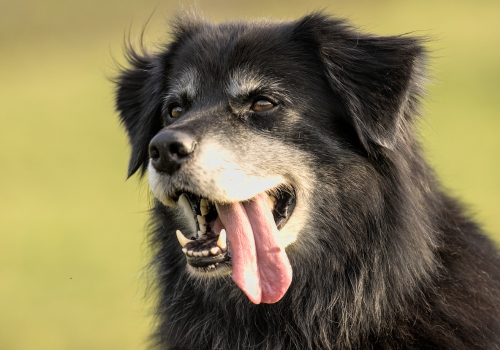40% of all dogs have arthritis. Could your dog be suffering in silence?
Around nine million people in the UK suffer from arthritis, but did you know it commonly affects our four-legged friends too? An estimated 40% of all dogs are living with this painful joint condition, but we often do not recognise the signs or put them down to old age. Read on, to find out if your dog could be suffering in silence and what we could do to help.


There are many different types of arthritis, but the most common is osteoarthritis. Healthy joints are covered by cartilage, a rubbery material that creates a cushion between the bones and provides a smooth surface for movement. When arthritis occurs, this cartilage breaks down, causing swelling, stiffness, movement problems and increasing pain, which steadily spreads throughout the body.
Arthritis is normally found in older and larger dogs, although it can affect youngsters too. It’s usually caused by natural wear and tear of the joints, but can also be linked to injuries, as well as joint abnormalities such as hip dysplasia.
How do I spot the symptoms?
Dogs are very good at hiding pain, which means they might not whimper or look obviously lame. Also, because our furry friends are four-legged (unlike us!), they are more adept at redistributing their weight to cope with discomfort.
As a result, a limp can be harder to spot. Nevertheless, there are some signs to look out for.
Stiffness, especially when getting up in the morning or when it’s cold and damp
Limping or hobbling
Subdued or uncharacteristically grumpy behaviour
Persistently licking their fur
Changes in posture when running, or lying down
Sleepiness, or a general lack of energy
Reluctance to jump into the back of the car or onto the sofa
Less enthusiasm on walks
How is arthritis managed?
As always, the earlier a problem is spotted, the stronger our chances of keeping pain at bay. If you have noticed any of the above symptoms in your pet, they may be suffering with arthritis pain so please do get in touch to arrange a thorough examination.
If your pet is ever diagnosed with arthritis, there are measures we can take to ensure a good quality of life.
The foundation of a successful arthritis management plan often start with good pain medication and with new medical advances, we will be able to recommend the best for your pet. It can also includes diet control and weight management, joint supplement or hydro/physiotherapy.
There’s also a lot you can do to help at home, by ensuring your pet has a comfortable bed, reduce walking on slippery floors, shorter but regular walks and much more. We’ll work with you to ensure a bespoke plan is in place to meet your pet’s needs.
Arthritis in dogs FAQs – Thrums Vets in Angus and Perthshire
Arthritis is a joint condition that causes inflammation, pain and stiffness as cartilage breaks down and bones rub together, which can reduce mobility and comfort.
Around 40% of dogs are affected by arthritis, especially older or larger breeds, though it can also occur in younger dogs due to injury or joint abnormalities.
Signs include stiffness after rest, limping, reluctance to jump or climb, slower movement, reduced exercise enthusiasm, difficulty standing or sitting, and occasional grumpiness.
Our vets can often diagnose arthritis through a physical examination. X-rays may be used to confirm the severity, while advanced imaging like CT or MRI, or joint fluid analysis, may be needed in some cases.
Treatment focuses on pain relief with medications like NSAIDs or injections such as Librela. We also recommend weight management, diet control, joint supplements, acupuncture, physiotherapy, hydrotherapy and massage as part of a comprehensive plan.
Yes. Acupuncture can reduce pain and inflammation, and hydrotherapy supports gentle exercise, muscle tone and joint mobility with reduced joint stress.
Provide a comfortable bed, avoid slippery floors, offer short but regular walks, maintain a healthy weight and follow the aftercare plan from your vet.
Dogs on long-term arthritis treatment benefit from regular consultations for monitoring. Practice Plan Extra members receive unlimited reviews, making ongoing management easier.
